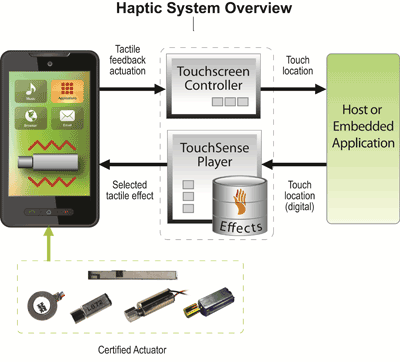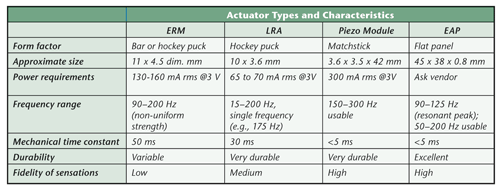Hardware/software involved in a haptics system plus considerations on how to select an actuator technology
BY ROB LACROIX
Vice President of Engineering
Immersion
www.immersion.com
Haptic technologies enable consumers to perceive touch sensations when using electronic devices. The touch sensation, created by an actuator embedded in the device, makes a virtual experience seem more physical and realistic.
Manufacturers have installed the technology in hundreds of millions of touchscreen consumer devices and they are becoming increasingly important in the handheld market as vendors strive to differentiate their products and win customer loyalty. A broad range of technology options are available. This article summarizes the hardware and software comprising a haptic system and the technical factors that must be considered when selecting an actuator technology for a handheld device.

Fig. 1: A complete overview of a haptic system.
Designing a haptic system
Haptic sensations are created by an actuator or motor that is controlled by embedded software and integrated into a device’s user interface via control software APIs. Adding an actuator to a device requires a systems-level integration approach to ensure components and software work together to create the best user experience.
A haptic system must integrate the following components:
• Actuator. In handheld devices, the actuator is typically mounted in a corner of the device casing to maximize the vibrations felt by the hand holding the device.
• Electronics. A haptic system in a handheld device will use a power amplifier to drive the actuator. The power amplifier takes device battery voltage (or a regulated 3 V) as the power source. A control signal input modulates the voltage applied across the actuator for a designated time period.
• Control software. The brains of a haptic system, control software should be fine-tuned to the capabilities of the system’s actuator. The controller takes an abstract instruction from a software application and runs a control algorithm that will continually adjust the voltage applied across the actuator to create the desired sensation.
• Application software. The software visible to the device user, application software coordinates the playback of touch effects according to prescribed user-interface events. Haptic behavior can be implemented at the application or OS level.
Criteria for selecting an actuation technology
Several factors must be considered when selecting an actuator for a handheld product. While cost and vendor relationships are always critical in purchasing decisions, design criteria determine whether an actuation technology is suitable for a particular device and frequently influence cost and performance. The most important design criteria include size and form factor, durability, and the actuator’s dynamic performance (the actuator’s rise time, expressed as the mechanical time constant, and its vibration strength).
Types of actuators
Four types of actuators are used in haptic systems, and each has specific functionality and performance characteristics that will influence its suitability for a particular product (see table ).

1. Eccentric rotating mass (ERM) actuators
ERMs are best used for slow, deliberate user-interface applications such as gaming rumble effects. ERMs are produced in tremendous volumes therefore provide one of the most cost-effective actuator alternatives for mass-market devices.
Typically bar-shaped and as small as 11 mm in length with a swing diameter of 4.5 mm, an ERM takes up little footprint on a device. ERMs have a current requirement of 130 to 160 mA during operation. They vibrate at frequencies within the 90 to 200-Hz range, although they tend to be much weaker at the lower frequencies. They have a relatively high mechanical time constant (around 50 ms), which is not suitable when providing touch sensations for fast typing on a virtual keyboard. Durability is good to excellent, depending on the model.
Coin motors are very inexpensive and very thin (2 mm high and 10 mm in diameter). However, except for the very best of these products, most coin motors are extremely sluggish, not durable, and unsuitable for haptic applications.
2. Linear resonant actuators (LRAs)
LRAs are well suited for haptics and are therefore used in many smartphones. LRAs have a hockey puck form factor. They can be as small as 10 mm in diameter by 3.6 mm high, and vendors are developing even thinner designs. LRAs require ac input and use the signal to vibrate a mass at a single frequency within the 150 to 200-Hz range. The devices draw current at around 65 to 70 mA. They have a mechanical time constant of about 30 ms. LRAs are durable because they have no bearings and the parts are not subjected to friction. They are more costly than ERMs and they require more sophisticated control to prevent resonant ringing.
3. Piezo modules
Piezo modules are high-performing actuators and can be used to create high-fidelity haptic effects. They can be applied in smartphones and can easily fit into tablet devices. Currently available in a matchstick form factor, these modules, can measure 3.6 x 3.5 x 42 mm.
Piezo modules have many advantages. They have a superior mechanical time constant (less than 5 ms), which makes them suitable for touch typing feedback, and they vibrate at a wide range of frequencies (150 to 300 Hz), which provides the flexibility to create a variety of highly nuanced touch sensations.
Piezo modules do come at a cost. They need an amplifier that can drive the capacitive load up to ±70 V. The required instantaneous power draw is high — roughly 300 mA at 3-V supply — but in practice they consume no more energy than ERM/LRA options. Piezo modules are very durable despite their inherently brittle ceramic material; they’ve been engineered to survive the rigorous drop test regimens typical for handheld devices.
4. Electro-active polymer actuators (EAPs)
Electro-active polymer technology is used in high-end smartphones. An EAP actuator is a wide but very flat panel (45 x 38 x 0.8 mm) that is affixed to an external movable mass, typically the device’s own battery, which is then mounted in a sled that is engineered to resonate anywhere from 90 to 125 Hz. The EAP mechanical time constant is in the low milliseconds.
EAP solutions require electronics that can generate an 800 V signal. The sled can be challenging to integrate into very tight spaces, but the actuator material itself is extremely thin and can have excellent durability. An EAP solution offers similar performance to a Piezo module.
Electronics requirements depend on the actuator used
A haptic system needs appropriate drive electronics to provide the current levels necessary to induce vibration.
For systems aimed at large-volume production and that have ample processing power on the device’s main processor, the electronics are provided by a simple command interface and a power stage. For systems that do not have a lot of onboard computing power, a small microcontroller is added to perform the control operations needed to create the desired haptic effects.
A third option is to embed the haptic controller as function block included in a multipurpose microcontroller. For example, a microcontroller could include a haptic controller block that is added to the capacitive button sensing functionality on the chip. The microcontroller can then be connected to the power amplification circuit.
Embedded and integration software
Control software, such as the TouchSense and MOTIV solutions from Immersion, includes APIs developers can use to create, launch and modulate haptic effects; integrator tools that OEMs can use to add haptic capabilities into the OS; and SDKs developers can use to integrate application-level haptic effects. These integration and development tools fully employ haptic system elements to create compelling user experiences with haptic effects. ■
Advertisement
Learn more about Immersion





